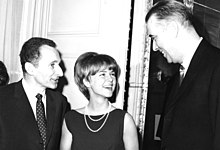Walter Rossow


Walter Rossow (born January 28, 1910 in Berlin , † January 2, 1992 in Berlin) was a German landscape architect and university professor.
Life
Walter Rossow was born in 1910 in Rixdorf, today's Berlin-Neukölln . During his school days, his interest was drawn to gardening. Contrary to his father's opinion, he completed an apprenticeship as a gardener in the Berlin city gardening department from 1926 to 1928. From 1930 he studied at the Teaching and Research Institute for Horticulture (LuFA) in Berlin-Dahlem . From 1932 he was a guest student at the Berlin Art Academy . In 1932 he completed his studies with the exam to become a garden technician.
From the spring of 1933 he worked for Martha Willings, a well-known garden technician in Berlin. In 1934, the Willings & Rossow office emerged. During the Nazi era, the v. a. on executive work. Walter Rossow categorically rejected the Nazi regime. This was also due to his private environment. In 1940 Rossow became the owner and manager of Willings & Rossow.
From 1945 to 1948 he headed the office for green spaces for the American occupation forces in Berlin. He worked closely with Hans Scharoun . In 1948 he took up a position as a lecturer at the Berlin University of Fine Arts. 1950–51 he was the site manager for the reconstruction of the zoo.
Rossow was mainly active in Berlin. Together with the architects Bruno Taut and Hans Hoffmann , he took part in numerous competitions and was also very successful. With this team he also designed the Schillerpark estate in Berlin-Wedding , which is now a World Heritage Site .
In 1958 he created the outdoor space around the German Pavilion designed by Egon Eiermann and Sep Ruf for the World Exhibition in Brussels, and in 1960 the green spaces for the Berlin Academy of the Arts on Hanseatenweg by Werner Düttmann .
1962-67 he designed the German military cemetery Futapass ( Italian: Cimitero Militare Germanico della Futa ) in Italy in collaboration with the architects Dieter Oesterlen , the landscape architect Ernst Cramer and the sculptor Helmut Lander . The complex is considered to be one of the most important examples of Central European landscape architecture of that time.
From October 1966 Rossow was professor and director of the Institute for Landscape Planning of the Faculty of Architecture and Urban Planning at the University of Stuttgart until 1975. From 1976 to 1986 he was director of the architecture department at the Berlin Academy of the Arts.
Rossow died in Berlin in 1991 at the age of almost 82. His professional estate is kept in the architecture archive of the “Foundation Archive of the Academy of the Arts Berlin ”. Rossow had been married to Helga von Hammerstein-Equord (1913-2005), daughter of General Kurt von Hammerstein , since June 1939 . The son Walter was adopted by the couple in 1945.
Memberships and honors
He was a member of the German Werkbund Berlin and was one of the signatories of the Green Charter of Mainau .
- 1958 Berlin Critics' Prize for fine arts
- 1963 Bonatz Prize Stuttgart
- 1966 Berlin Art Prize
- 1971 Schumacher Prize Hanover
- 1972 Order Pour le mérite for science and the arts
- 1974 Great Cross of Merit with Star of the Federal Republic of Germany and
- 1975 Friedrich Ludwig von Sckell Ring of Honor from the Bavarian Academy of Fine Arts .
- 1985 Honorary doctorate from TU Darmstadt .
Publications
Walter Rossow has made several dozen publications in magazines and newspapers.
- The landscape must become the law (Ed. By Monika Daldrop-Weidmann). Stuttgart: DVA, 1991, ISBN 3-421-03001-4 .
literature
- Monique van Rijn, Vladimir Voracek (eds.): Festschrift for the 70th birthday of Professor Walter Rossow . Monique van Rijn (self-published), Stuttgart 1980
- Donata Valentien, Christoph Valentien: Rossow, Walter. In: New German Biography (NDB). Volume 22, Duncker & Humblot, Berlin 2005, ISBN 3-428-11203-2 , p. 97 f. ( Digitized version ).
- Andrea Koenecke: Walter Rossow (1910–1992). "The landscape in the public consciousness", Munich 2014.
Web links
- Literature by and about Walter Rossow in the catalog of the German National Library
- Walter Rossow Archive in the Archive of the Academy of Arts, Berlin
| personal data | |
|---|---|
| SURNAME | Rossow, Walter |
| BRIEF DESCRIPTION | German landscape architect |
| DATE OF BIRTH | January 28, 1910 |
| PLACE OF BIRTH | Berlin |
| DATE OF DEATH | 2nd January 1992 |
| Place of death | Berlin |